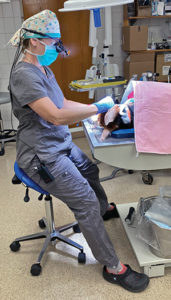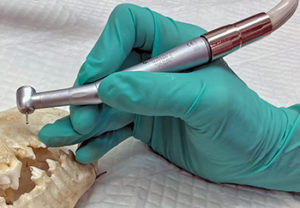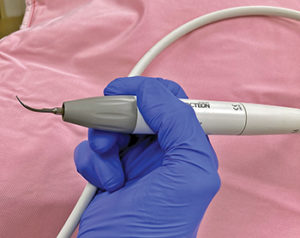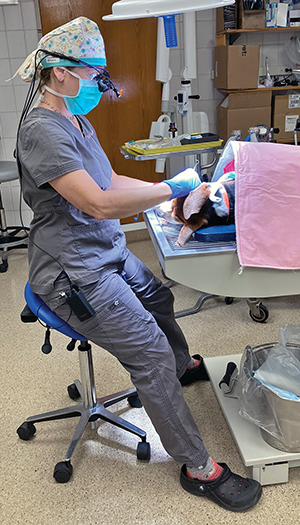Information abounds to help veterinarians develop and improve their dental diagnostic and treatment skills. This article, however, describes devices and techniques that can make the practice of dentistry more ergonomic, comfortable, and easy.
Loupes and Lights

Loupes provide illumination and fixed magnification. The adjustable-brightness lamp may be tilted for optimal viewing. Loupes are fitted to the individual’s focal depth, arm length, desired degree of magnification, etc. There is an initial acclimation period.
Frame-mounted objectives can be tilted, the interpupillary distance can be adjusted, and the objectives can be changed by the user. However, the weight of the loupes is further from the head, increasing fatigue. Objectives mounted through the lenses places the weight closer to head, reducing fatigue, but they may only be changed by the vendor.
Loupes allow the operator to sit upright with the head above the shoulders and tilted <20 degrees, to prevent neck pain or injury. A cheaper, universal alternative is a binocular headband magnifier, some models of which can be fitted with a light. Alternatively, a tilting camp or runner’s light on a headband is an inexpensive light source.
Tables and Chairs
Deeper tables may not allow the knees to fit underneath, and shorter operators may have trouble reaching foot pedals with the exam stool raised to a comfortable height. A powered table adjusts to the height of the operator and may be positioned low enough to ease lifting large patients.
When the practitioner leans forward on a standard exam chair with the thighs parallel to the floor, the lumbar spine is flattened, causing discomfort. A saddle or straddle stool with a downward-tilting seat allows “supported standing” and promotes a neutral spine posture, reducing back and neck pain. The optimal angle at the hip between the upper body and thighs should be between 100 degrees and 110 degrees.

Big and Little Tools
Dental operatory equipment can impact ergonomics and even operator health. A noisy, exposed air compressor can increase fatigue and affect hearing. Table-mounted anesthesia vaporizers and dental handpieces reduce tripping hazards, free up floor space, and bring equipment within easy reach of the practitioner.
A modified pencil grip allows fine instrument movements and rotation guided by the fingers. Hold the instrument or handpiece between the thumb and index finger in a pincer grasp. The middle finger supports the handpiece, the ring finger rests on the patient to steady the hand, and the pinky is along for the ride. The handpiece cord may be looped and held with the pinky to stop it from dragging the hand down.

The smaller pieces of the dental armamentarium also impact ergonomics and ease of use. Dental and periosteal elevators are available in a variety of shank and handle lengths to fit different sized hands and technique styles. Dental elevators with a curved or bent shank allow the practitioner to more easily reach distal teeth or to bypass the occluding arcade, especially in smaller patients.
Improving clinical dentistry skills is relevant to veterinarians. Improving ergonomics can allow veterinarians to deliver dental care more comfortably, and later into their career.
Contact the Dentistry Service at 217-333-5859 or vthdentistry@vetmed.illinois.edu.
By Amy Somrak, MBA, DVM, DAVDC




